
Concept explainers
(a)
Interpretation: The name of the following compound needs to be determined.

Concept Introduction : The name of an organic compound has three parts, prefix, parent chain and suffix. The format of naming is prefix+parent chain+suffix. The parent chain is the longest chain of carbon atoms in the compound. Suffix denote the name of functional group and prefix denote the substituent present in the compound.
(a)
Answer to Problem 15E
The name of the compound is 1,3-dichlorobutane.
Explanation of Solution
The compound is as follows:

First identify the parent chain of the compound. The parent chain consists of four carbon atoms. So, the name of parent chain is ‘but’. The compound consist of only single bonds so, name of suffix ‘ane’ should be used. Two chlorine atoms present in C1 and C3. So, the name of the compound is 1,3-dichlorobutane.
(b)
Interpretation: The name of the following compound needs to be determined.
Concept Introduction : The name of an organic compound has three parts, prefix, parent chain and suffix. The format of naming is prefix+parent chain+suffix. The parent chain is the longest chain of carbon atoms in the compound. Suffix denote the name of functional group and prefix denote the substituent present in the compound.
(b)
Answer to Problem 15E
The name of the compound is 1,1,1-trichlorobutane
Explanation of Solution
The compound is
(c)
Interpretation: The name of the following compound needs to be determined.
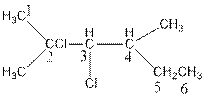
Concept Introduction : The name of an organic compound has three parts, prefix, parent chain and suffix. The format of naming is prefix+parent chain+suffix. The parent chain is the longest chain of carbon atoms in the compound. Suffix denote the name of functional group and prefix denote the substituent present in the compound.
(c)
Answer to Problem 15E
The name of the compound is 2, 3-dichloro-2-4-dimethyhexane
Explanation of Solution
The compound is as follows:
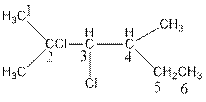
The parent chain consists of six carbon atoms. So, the name of parent chain is ‘hex’. Only single bonds present in the compound. So, suffix would be ‘ane’. Two chlorine atoms present in C2 and C3 and two methyl atoms present in C2 and C4. So, the name of the compound is 2,3-dichloro-2-4-dimethyhexane.
(d)
Interpretation: The name of the following compound needs to be determined.
Concept Introduction: The name of an organic compound has three parts, prefix, parent chain and suffix. The format of naming is prefix+parent chain+suffix. The parent chain is the longest chain of carbon atoms in the compound. Suffix denote the name of functional group and prefix denote the substituent present in the compound.
(d)
Answer to Problem 15E
The name of the following compound is 1,2-difluoroethane
Explanation of Solution

In
(e)
Interpretation: The name of the following compound needs to be determined.

Concept Introduction: The name of an organic compound has three parts, prefix, parent chain and suffix. The format of naming is prefix+parent chain+suffix. The parent chain is the longest chain of carbon atoms in the compound. Suffixdenote the name of functional group and prefix denote the substituent present in the compound.
(e)
Answer to Problem 15E
The name of the compound is 3-iodobut-1-ene.
Explanation of Solution
The compound is,

The parent carbon chain consists of four carbon atoms. So, the name of the parent chain is ‘but’, double bond present. So, name of suffix is ‘ene’. One iodine atom present at C3. So, the name of the compound is 3-iodobut-1-ene.
(f)
Interpretation: The name of the following compound needs to be determined.
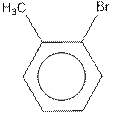
Concept Introduction: In naming of benzene compound prefix is used to denote the substituents present in the compound before the word ’benzene’. If more than one substituent is present, then the substituents are arranged in alphabetical order.
(f)
Answer to Problem 15E
The name of the compound is 1-bromo-2-methylbenzene.
Explanation of Solution
The name of the compound is as follows:

The compound is a benzene compound. One bromine atom is present at C1 and one methyl group is at C2. So, the name of the compound is 1-bromo-2-methylbenzene.
(g)
Interpretation: The name of the following compound needs to be determined.
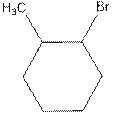
Concept Introduction: In naming of cyclic compound, naming is done in the format,
Prefix+Cyclo+parent chain+suffix
Prefix denotes the name of the substituent. If more than one substituent is present then they should be arranged in alphabetical order.
(g)
Answer to Problem 15E
The name of the compound is 1-bromo-2-methylcyclohexane.
Explanation of Solution
The compound is as follows:

The above compound is cyclic compound. One bromine atom is present at C1 and one methyl atom is present at C2. And the parent chain consists of six carbon atoms. So, the name of the compound is 1-bromo-2-methylcyclohexane.
(h)
Interpretation: The name of the following compound needs to be determined.
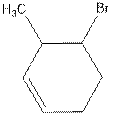
Concept Introduction: In naming of cyclic compound, naming is done in the format,
Prefix+Cyclo+parent chain+suffix
Prefix denotes the name of the substituent. If more than one substituent is present, they should be arranged in alphabetical order.
(h)
Answer to Problem 15E
The name of the compound is 1-bromo-2-methylcyclohex-3-ene.
Explanation of Solution
The compound is as follows:

The above compound is cyclic compound. One bromine atom is present at C1 and one methyl atom is present at C2. The parent chain consists of six carbon atoms and one double bond at C3. So, the name of the compound is 1-bromo-2-methylcyclohex-3-ene.
Want to see more full solutions like this?
Chapter 21 Solutions
Chemical Principles
- Where is the correct point to start numbering the structure in Figure 11? * A B C D Earrow_forwardIs there any difference between 2-methylpropane and isobutane? Why is the structure in the image not named 2-methylpropane but isobutane. What is meant by "iso"?arrow_forwardWhat are hydrocarbons?arrow_forward
 Chemistry: An Atoms First ApproachChemistryISBN:9781305079243Author:Steven S. Zumdahl, Susan A. ZumdahlPublisher:Cengage Learning
Chemistry: An Atoms First ApproachChemistryISBN:9781305079243Author:Steven S. Zumdahl, Susan A. ZumdahlPublisher:Cengage Learning ChemistryChemistryISBN:9781305957404Author:Steven S. Zumdahl, Susan A. Zumdahl, Donald J. DeCostePublisher:Cengage Learning
ChemistryChemistryISBN:9781305957404Author:Steven S. Zumdahl, Susan A. Zumdahl, Donald J. DeCostePublisher:Cengage Learning
 Introductory Chemistry: A FoundationChemistryISBN:9781337399425Author:Steven S. Zumdahl, Donald J. DeCostePublisher:Cengage Learning
Introductory Chemistry: A FoundationChemistryISBN:9781337399425Author:Steven S. Zumdahl, Donald J. DeCostePublisher:Cengage Learning Living By Chemistry: First Edition TextbookChemistryISBN:9781559539418Author:Angelica StacyPublisher:MAC HIGHER
Living By Chemistry: First Edition TextbookChemistryISBN:9781559539418Author:Angelica StacyPublisher:MAC HIGHER




